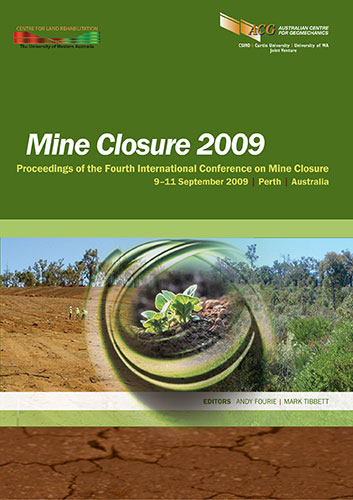South Africa’s challenges pertaining to mine closure — development and implementation of regional mining and closure strategies

|
Authors: van Tonder, DM; Coetzee, H; Esterhuyse, S; Strachan, L; Wade, P; Mudau, S Paper is not available for download Contact Us |
DOI https://doi.org/10.36487/ACG_repo/908_3
Cite As:
van Tonder, DM, Coetzee, H, Esterhuyse, S, Strachan, L, Wade, P & Mudau, S 2009, 'South Africa’s challenges pertaining to mine closure — development and implementation of regional mining and closure strategies', in AB Fourie & M Tibbett (eds), Mine Closure 2009: Proceedings of the Fourth International Conference on Mine Closure, Australian Centre for Geomechanics, Perth, pp. 79-91, https://doi.org/10.36487/ACG_repo/908_3
Abstract:
Following the World Summit on Sustainable Development in 2002, the South African Department of Minerals and Energy (DME) initiated the “Sustainable Development through Mining” (SDM) programme to assist in the development of a strategic framework for sustainable development in the minerals and mining sector. This initiative supported a variety of projects including a project specifically orientated towards integrated regional mine closure and its implications. This paper focuses on the increasingly challenging environment of changing community expectations, stricter regulatory controls and greater public scrutiny in areas of cumulative, interconnected, or multi-mine, and/or an integrated environmental and socio-economic impact at a regional level. The paper discusses the challenges in the development and implementation of the concept of regional mine closure strategies, as support to further policy and legislative interventions in South Africa, and outlines proposed strategies to address these challenges. Regional closure strategies aim to provide a framework within which mines can develop closure plans that address broader development priorities as well as possible cumulative impacts of a number of mines, taking into consideration socio- economic and environmental issues on a regional basis. A strategic framework was developed for the Witwatersrand gold mining region within which individual mines will be able to plan for mine closure. In order for the strategy to be implemented there are a number of key success factors. These include issues around closure planning, buy-in from stakeholders, trade-offs, stakeholder engagement, setting-up of completion criteria (balanced scorecard for regional mine closure), targeted research and data management. This paper is a follow-up on work reported.
References:
Coetzee, H., Wade, P. and Winde, F. (2002) Reliance on existing wetlands for pollution control around the
Witwatersrand gold/uranium mines of South Africa – are they sufficient? In Uranium in the Aquatic
Environment, B.J. Merkel, B. Planer-Friedrich and C. Wolkersdorfer (eds), Springer, Berlin, Heidelberg,
pp. 59–65.
Coetzee, H., Winde, F. and Wade, P. (2006) An assessment of sources, pathways, mechanisms and risks of current and
future pollution of water and sediments in the Wonderfonteinspruit Catchment, Water Research Commission,
WRC Report No. 1214/1/06, Pretoria, 202 p.
Durrheim, R.J., Anderson, R.L., Cichowicz, A., Ebrahim-Trollope, R., Hubert, G., Kijko, A., McGarr, A., Ortlepp,
W.D. and Van der Merwe, N. (2006) The risks to miners, mines, and the public posed by large seismic events in
the gold mining districts of South Africa, In Proceedings of the Third International Seminar on Deep and High
Stress Mining, J. Hadjigeorgiou and M. Grenon (eds), Laval University, Canada, pp. 1–14.
Planning for closure
Mine Closure 2009, Perth, Australia 91
Felleman, J.P. (1986) Landscape Visibility, In Foundation for Visual Project Analysis, R.C. Smardon, J.F. Palmer and
J.P. Felleman (eds), John Wiley, New York, USA, pp. 47–62.
O’Riordan, T. and Cameron, J. (1994) Interpreting the precautionary principle, Earthscan Publications, London, 316 p.
Pulles, W., Bannister, S. and van Biljon, M. (2005) The development of appropriate procedures towards and after
closure of underground gold mines from a water management perspective, Water Research Commission, WRC
Report No. 1215/1/05, Water Research Commission, Pretoria, 138 p.
Robb, L.J. and Robb, V.M. (1998) Gold in the Witwatersrand Basin: In Handbook, Council for Geoscience, M.G.C.
Wilson and C.R. Anhaeusser (eds), Vol. 16, pp. 294–349.
Swart, E. (2003) The South African legislative framework for mine closure, Journal of the South African Institute of
Mining and Metallurgy, pp. 489–492.
van Tonder, D.M., Coetzee, H., Esterhuyse, S., Msezane, N., Strachan, L., Wade, P., Mafanya, T. and Mudau, S.
(2008a) South Africa’s challenges pertaining to mine closure – The concept of regional mine closure strategy, In
Proceedings of the Third International Seminar on Mine Closure, Mine Closure 2008, A.B. Fourie, M. Tibbett,
I.M. Weiersbye, P. Dye (eds), 14–17 October 2008, Johannesburg, South Africa, Australian Centre for
Geomechanics, Perth, pp. 87–98.
Van Tonder, D.M., Coetzee, H., Strachan, L.K.C., Mafanya, T., Wade, P.W., Msezane, N., Kwata, M.G., Roos, M.,
Sebake, D., Mengistu, H., Yibas, B. and Esterhuyse, S. (2008b) Regional gold mining closure strategy for the
Witwatersrand Basin (Report prepared for the Department of Minerals and Energy), Sustainable Development
through Mining Project Reports, Department of Minerals and Energy, Council for Geoscience Report No. 2008–
0179, Pretoria, 140 p.
World Health Organisation (WHO) (1999) Guidelines for Air Quality, World Health Organisation, Cluster of
Sustainable Development and Healthy Environment (SDE), Department of the Protection of the Human
Environment (PHE), Division of Occupational and Environmental Health (OEH), Geneva, 186 p.
© Copyright 2025, Australian Centre for Geomechanics (ACG), The University of Western Australia. All rights reserved.
View copyright/legal information
Please direct any queries or error reports to repository-acg@uwa.edu.au
View copyright/legal information
Please direct any queries or error reports to repository-acg@uwa.edu.au